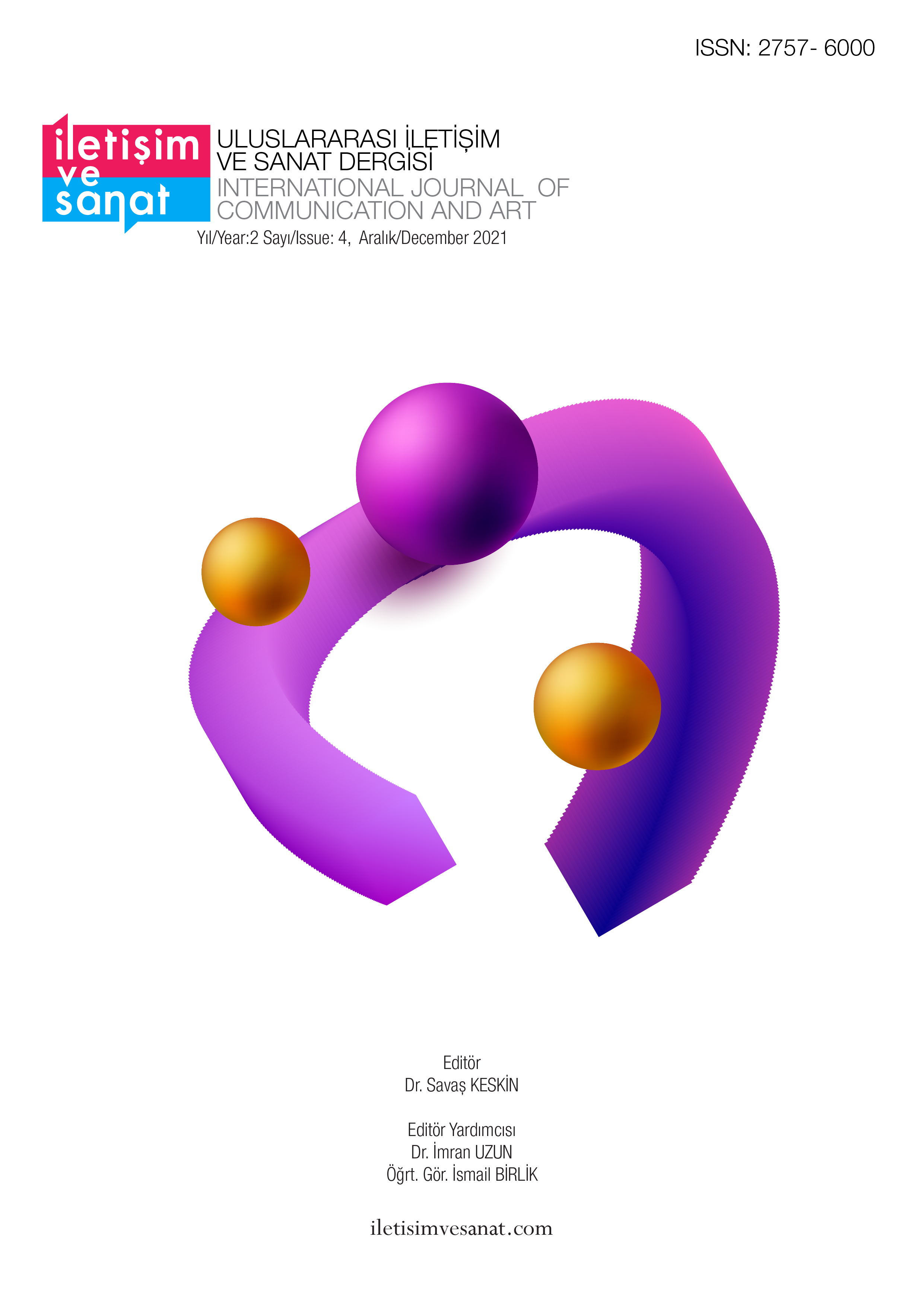Author :
Abstract
Mekân canlıların yalnızca içinde barındıkları bir alan olmamıştır hiçbir zaman. Canlıları dış etkenlerden saklamış, korumuş ve içinde yaşayanların, dışarıdan gelen saldırılardan sağ çıkmasını sağlamıştır. Mekânın koruma ve saklama güdüsünün ötesinde yaşayanlara yuva olması, bu kavram içinde ailelerin kurulmasına izin vermesi mekâna kutsallık atfetmiştir. Gizlenmenin, içine almanın ve sığınmanın kutsallığı “mekân” kavramıyla ete kemiğe bürünmüştür. Elbette ki bu kavramın ele alınış biçimi mekânın nasıl tasarlanacağı fikrini de beraberinde getirmiştir. Mekânın tasarımı, işlevselliği doğrultusunda gerçekleştirilmiş ve dinsel ritüelle, kültürel dokuyla, içinde bulunulan coğrafyayla ve zamanın getirdiği teknolojiyle yoğrulduğu görülmüştür. Animasyonlarda yer alan mekân tasarımına dair algılamalar, izleyiciye gerçeklik duygusunu geçirmekte ve tasarım – mekân – zaman arasında güçlü bir bağ kurulmasını sağlamaktadır. Bu çalışmayla birlikte; El Dorado Yolu, Herkül ve Mısır Prensi animasyonları mekân ve tarihi gerçeklik açısından karşılaştırılmış olup, mekânın tarihi gerçeklerle uygunluğu tespit edilmeye çalışılmıştır. Filmin konusuna, zamanın uygunluğuna, karakterlerle iç içe geçişine ve mekânda yer alan görsel aktarımların, dokusal değerlerin gerçek ile olan bağlantısı gösterilmeye çalışılmıştır. Mekânda kullanılan öğelerin, detayların tasarım bütünlüğü açısından ele alınmış olması bu tarz animasyonları daha iyi değerlendirmemizi sağlamakta, izleyicide yarattığı gerçeklikle izleyicinin hikâye içerisine dahil olmasını kolaylaştırmaktadır. Çalışmanın, animasyon ve tasarım alanlarında yer alan profesyoneller ve öğrenciler için faydalı olması amaçlanmıştır.
Keywords
Abstract
Space has never been just a place where living things take shelter in. It has hidden and protected living things from foreign factors, and ensured that those living inside survived the attacks coming from outside. Beyond the instinct of protection and preservation, the fact that space is a home for the living things and allowing them to start a family within this concept, has sanctified it. The sanctity of hiding, embracing and taking shelter was shaped in flesh and bones with the concept of "space". Of course, the way this concept is addressed has brought about the idea of how the space would be designed. The design of the space was realized in line with its functionality and it was witnessed that this design was kneaded with religious ritual, cultural texture, the present geography and the technology of the time. The perceptions of the space design featured in the animations convey the sense of reality to the viewer and allow for a strong connection between design, space and time. Within the scope of this study, animations such as El Dorado Road, Hercules and Egyptian Prince were compared in terms of space and historical reality, and it was attempted to determine the compatibility of the space with historical facts. The subject of the movies was evaluated with regards to the compatibility of the characters and the time. The visual textures featured in the space were compared with the period and its own characteristic structure and narrated in this study. The fact that the elements used in the space and the details are addressed in terms of design integrity enables us to better evaluate such animations, and facilitates the inclusion of the viewers in the story thanks to the reality effect induced on them. The study is aimed to be helpful for the professionals and students involved in the fields of animation and design.
Keywords
- Açıköğretim (t.y.). “12. Yeni Krallık Döneminde Mısır’ın Anıtsal Mimarisi ve Plastik Sanatlarından Örnekler”, T.Y. https://cdnacikogretim.istanbul.edu.tr/auzefcontent/20_21_Guz/eski_misir_tarihi/12/index.html, Erişim Tarihi: 11 Ekim 2021.
- Arezzolo, A. (2021). “Setting the Scene and Establishing Audience Engagement: The Use of Settings and Classical Backdrops in Disney’s Hercules”, https://antipodeanodyssey.wordpress.com/2021/02/, Erişim Tarihi: 11.11.2021.
- Aslıtürk, G. E. ve Küçükgüney, E. (2016). 20. Yüzyıl Resim ve Heykellerı̇nı̇n Yunan Mı̇tolojı̇sı̇ ve İkı̇cı̇lı̇k Kavramı Açısından Değerlendı̇rı̇lmesı̇ne Yönelik Bir Araştırma, Ulakbilge, 4 (8), 263-298.
- Beyazperde (t.y.). “Mısır Prensi”, t.y. https://www.beyazperde.com/filmler/film- 27657/, Erişim Tarihi: 06 Ekim 2021.
- Bueno, I. (2018). “Machetes and Sketchbooks İntroduced the Maya to the World”, https://www.nationalgeographic.com/history/history-magazine/article/history-mayaarchaeology-stephens-catherwood, Erişim Tarihi: 29 Ekim 2021.
- Can, Ş. (2020). Klasik Yunan Mitolojisi, İstanbul: Ötüken Yayınları.
- Drye, W. (t.y.). “El Dorado”, https://www.nationalgeographic.com/history/article/el-dorado, Erişim Tarihi: 07 Kasım 2021.
- Estin, C. ve Laporte, H. (2002). Yunan ve Roma Mitolojisi, Ankara: Tubitak Yayınları.
- Kaya, K. (2019). “En Güzel 10 Antik Maya Tapınağı”, https://www.turna.com/blog/en-guzel-10-antik-maya-tapinagi, Erişim Tarihi: 09 Kasım
- IMBD. (t.y.). “Herkül”, https://www.imdb.com/title/tt0119282/, Erişim Tarihi: 05 Kasım 2021.
- Marie, R. ve Hagen, R. (2005). Egypt, Köln: Taschen.
- Sarıberberoğlu, M. T. (2019). “Sinematik Kurgunun Bilinçaltı Mekânları-Tekinsiz Mekânlar”, Mimarlık ve Yaşam Dergisi, 5(1), 27-39.
- Türkçebilgi (t.y.). “Stoa”, t.y. https://www.turkcebilgi.com/stoa#post, Erişim Tarihi: 11 Ekim 2021
- The Imperial Gazetteer 1856 (2020). “Denderah, Egypt”, https://victorianweb.org/history/empire/egypt/denderah.html, Erişim Tarihi: 10 Kasım
- Sinemalar (2021). “Herkül”, https://www.sinemalar.com/film/2070/herkul, Erişim Tarihi: 05 Kasım 2021.





